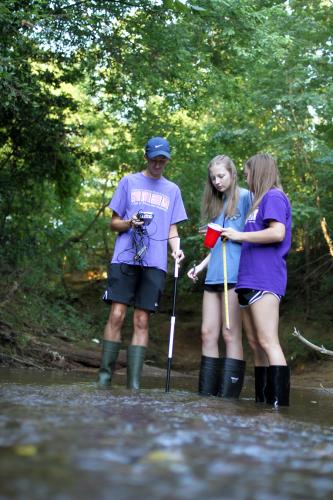NACOGDOCHES, Texas — Wading into Lanana Creek, three Nacogdoches High School seniors enrolled in Stephen F. Austin State University’s STEM Academy collect water samples to test the creek’s water quality. It’s 7:30 a.m., and immediately the students take note of the environment, jotting down the temperature, humidity and pointing out the creek’s shallowness.
After recording their initial observations, Brandon Smith, Marin Beal and Miranda Allbee take the water’s temperature and measure the depth and flow rate at different locations along the creek.
“We are looking at the water quality in the creek both upstream and downstream of the bridge construction to see if it’s affecting the water,” Smith explained.
Since the first week in July, the three students have been collecting samples at Lanana Creek for their research project, which is a requirement of SFA’s STEM Academy for fourth-year students.
Through the STEM Academy, which is part of SFA’s College of Sciences and Mathematics, students from Nacogdoches and Lufkin High Schools are exposed to rigorous science, technology, engineering and mathematics curriculum and investigative laboratory and field experiences.
SFA STEM’s curriculum is delivered at the high school campuses and tailored to match science course curriculum. Students in the STEM Academy also participate in half-day visits to SFA laboratories and field sites every three weeks where they interact with and learn from SFA faculty members.
Dr. Dennis Gravatt, associate professor of biology at SFA, works with many STEM Academy students, including Smith, Beal and Allbee.
“The academy offers students an opportunity to experience science outside of their high school courses,” Gravatt said. “They are exposed to different facets of science that they wouldn’t be exposed to otherwise.”
The academy is organized by class level, and each level has a specific focus area. For example, freshmen are in STEM 1, which is focused on biology; sophomores are in STEM 2, which is centered on chemistry; and juniors are in STEM 3, which is mainly physics. During their fourth year, STEM Academy students engage in experimental design and conduct their own research.
Smith, Beal and Allbee are one of many student groups working on their research for their final year in the academy.
“The STEM Academy is great because you get to do stuff like this,” Beal said, referencing the group’s ability to conduct field research at the creek.
Allbee agrees the academy provides more hands-on experiences, and although the academy is challenging, it is worth it.
“Before Brandon, Marin and Miranda began their project, we had a brainstorming session where we discussed all their options. I acted as a mentor and facilitator to help the students think critically, work through their research questions and instigate thoughts,” Gravatt said. “For the students, this was a great experience as they were able to see what it’s like working with scientists, asking questions and having discussions.”
After fine-tuning the research proposal, the students decided to study how the construction of the bridge on Starr Avenue would impact Lanana Creek’s water quality in regard to biological health. Gravatt explained the students collect samples in deep and shallow areas of the creek because different organisms live in each area, and each depth has different oxygen levels and temperatures.
Overall, the students will collect samples for six weeks, three times a week. They check the pH and oxygen levels, turbidity (how cloudy the water is), conductivity, and water temperature at the surface and bottom of the creek. Additionally, students look for macroinvertebrates, which are small organisms without backbones that are visible without a microscope such as dragonflies and damselflies.
Students will begin to analyze the data and discuss the implications of their findings during the fall. Other STEM Academy students are in various stages of their own research projects.

 Axe ’Em, Jacks!
Axe ’Em, Jacks!
